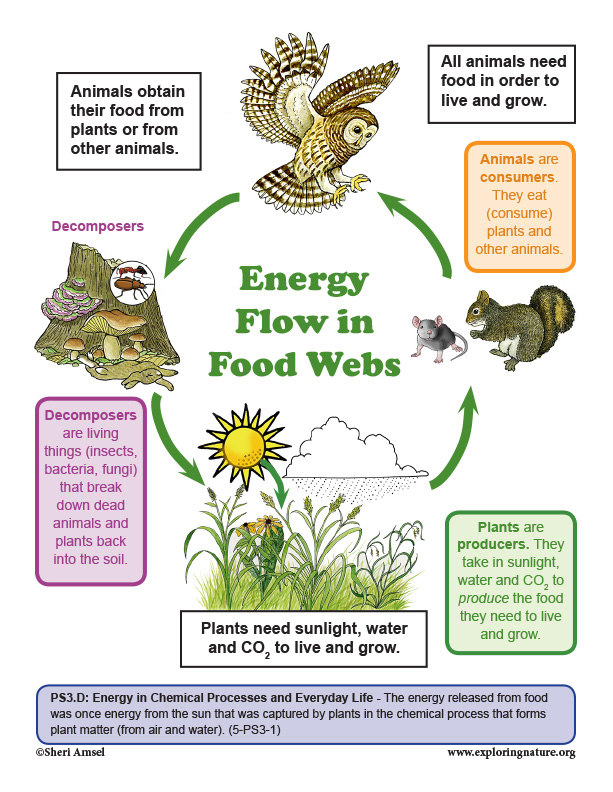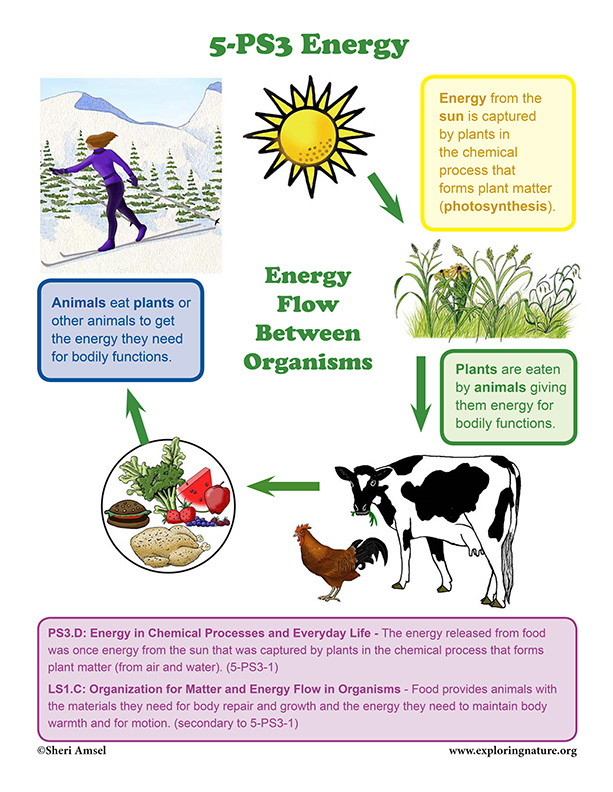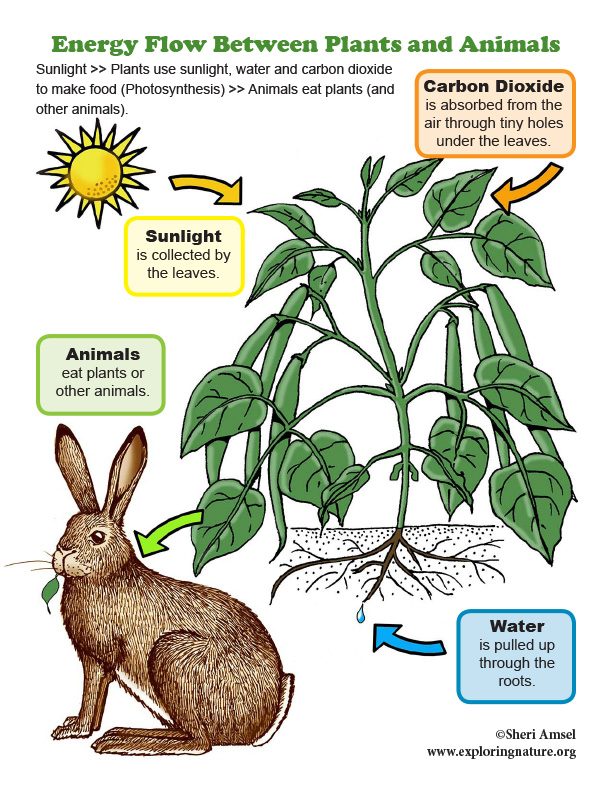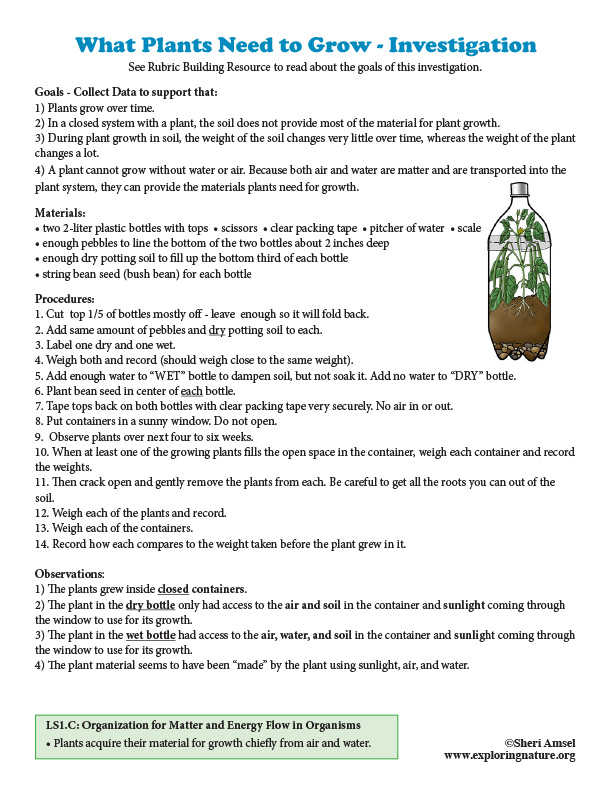

Disciplinary Core Ideas
PS3.D: Energy in Chemical Processes and Everyday Life
• The energy released [from] food was once energy from the sun that was captured by plants in the chemical process that forms plant matter (from air and water). (5-PS3-1)
LS1.C: Organization for Matter and Energy Flow in Organisms
• Food provides animals with the materials they need for body repair and growth and the energy they need to maintain body warmth and for motion. (secondary to 5-PS3-1)
Performance Expectations Students who demonstrate understanding can:
5-PS3-1. Use models to describe that energy in animals’ food (used for body repair, growth, motion, and to maintain body warmth) was once energy from the sun.
Clarification Statement: Examples of models could include diagrams, and flow charts.]
____________________________________________________________________________________________________________________________________________________________
Use the Template and Resource Links to Fulfill NGSS l. Goals for Enduring Understanding:
Essential Questions:
ll. Introductory Activities to Assess Prior Knowledge
A. Simple Activities - that assess students’ understanding of what plants need to grow.
What Living Things Need - Labeling
What Do All Living Things Need? Fill in the Blank
lll. New Knowledge - Text
A. Read about animals that live in groups and consider how this helps them.
Plant Structure - The Parts of a Plant and FlowerPhotosynthesis Simplified (Elementary Levels)
B. Examples of Models (depicts the concept expressed in the reading):
Ask students to look at the model of what a plant needs and explain how this works.
Energy Flow Between Organisms - Mini-Poster
Energy Flow in Food Webs - Mini-Poster
What Plants Need to Grow - Poster
Energy Flow Between Plants and Animals - Mini-Poster (Grade 5 NGSS)
Energy Flow Between Plants and Animals - Coloring Page
lV. Experiments, Activities, Model-making (Critical Thinking)
Inquiry related to social interactions and group behaviors. Choose and Research an animal that lives in a group and then use critical thinking to complete the social interactions and group behavior sheet below about them.
PS3.D: Energy in Chemical Processes and Everyday Life
Disciplinary Core Ideas
PS3.D: Energy in Chemical Processes and Everyday Life
• The energy released [from] food was once energy from the sun that was captured by plants in the chemical process that forms plant matter (from air and water). (5-PS3-1)
LS1.C: Organization for Matter and Energy Flow in Organisms
• Food provides animals with the materials they need for body repair and growth and the energy they need to maintain body warmth and for motion. (secondary to 5-PS3-1)
Science and Engineering Practices
Developing and Using Models
Modeling in 3–5 builds on K–2 experiences and progresses to building and revising simple models and using models to represent events and design solutions.
• Use models to describe phenomena. (5-PS3-1)
Crosscutting Concepts
Energy and Matter
• Energy can be transferred in various ways and between objects. (5-PS3-1)
Performance Expectations
Students who demonstrate understanding can:
5-PS3-1. Use models to describe that energy in animals’ food (used for body repair, growth, motion, and to maintain body warmth) was once energy from the sun. [Clarification Statement: Examples of models could include diagrams, and flow charts.]
Common Core State Standards Connections
ELA/Literacy
RI.5.7 Draw on information from multiple print or digital sources, demonstrating the ability to locate an answer to a question quickly or to solve a problem efficiently. (5-PS3-1)
SL.5.5 Include multimedia components (e.g., graphics, sound) and visual displays in presentations when appropriate to enhance the development of main ideas or themes. (5-PS3-1)
When you research information you must cite the reference. Citing for websites is different from citing from books, magazines and periodicals. The style of citing shown here is from the MLA Style Citations (Modern Language Association).
When citing a WEBSITE the general format is as follows.
Author Last Name, First Name(s). "Title: Subtitle of Part of Web Page, if appropriate." Title: Subtitle: Section of Page if appropriate. Sponsoring/Publishing Agency, If Given. Additional significant descriptive information. Date of Electronic Publication or other Date, such as Last Updated. Day Month Year of access < URL >.
Amsel, Sheri. "Grade 5 - 5-PS3 Energy" Exploring Nature Educational Resource ©2005-2024. December 14, 2024
< http://www.exploringnature.org/db/view/Grade-5-5-PS3-Energy >





